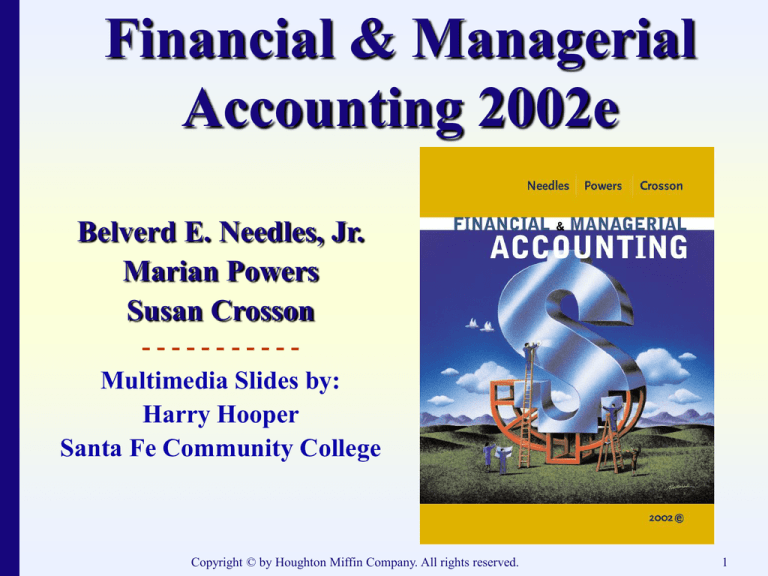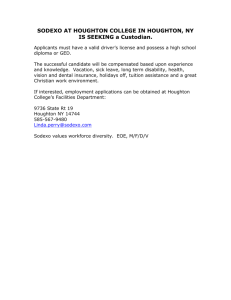
Financial & Managerial
Accounting 2002e
Belverd E. Needles, Jr.
Marian Powers
Susan Crosson
----------Multimedia Slides by:
Harry Hooper
Santa Fe Community College
Copyright © by Houghton Miffin Company. All rights reserved.
1
Chapter 23
Performance
Management and
Evaluation
Copyright © by Houghton Miffin Company. All rights reserved.
2
LEARNING OBJECTIVES
1. Describe how the balanced scorecard aligns
performance with organizational goals and
explain the balanced scorecard’s role in the
management cycle.
2. Discuss performance measurement and state the
issues that affect management’s ability to
measure performance.
3. Define responsibility accounting and describe
the role responsibility centers play in
performance management and evaluation.
Copyright © by Houghton Miffin Company. All rights reserved.
3
LEARNING OBJECTIVES
4. Prepare performance reports for the various types
of responsibility centers, including reports based
on the flexible budget for cost centers and variable
costing for profit centers.
5. Use the traditional performance measures of
return on investment and residual income to
evaluate investment centers.
6. Use economic value added to evaluate investment
centers.
7. Explain how properly linked performance
incentives and measures add value for all
stakeholders in performance management and
evaluation.
Copyright © by Houghton Miffin Company. All rights reserved.
4
Organizational Goals and the
Balanced Scorecard
OBJECTIVE 1
Describe how the balanced scorecard
aligns performance with organizational
goals and explain the balanced
scorecard’s role in the management
cycle.
Copyright © by Houghton Miffin Company. All rights reserved.
5
The Balanced Scorecard
A framework
that links the perspectives of an
organization’s 4 stakeholder groups:
Financial (investors)
Learning and growth (employees)
Internal business processes (management)
Customers
with the organization’s:
Mission and vision
Performance measures
Strategic plan
Resources
Copyright © by Houghton Miffin Company. All rights reserved.
6
The Balanced Scorecard
To
succeed, an organization must
add value for all stakeholders.
Determine each group’s objectives.
Translate their objectives into
performance measures that have
specific, quantifiable performance
targets.
Copyright © by Houghton Miffin Company. All rights reserved.
7
The Balanced Scorecard and the
Management Cycle
Planning
Example: Strategy is to achieve customer satisfaction
Perspective
Objectives
Performance Measures
Financial (investors)
Revenue growth
% growth in sales
dollars
Learning and growth
(employees)
Trained employees
Number of trained
employees, employee
turnover
Internal business
processes
Reliable products, short
delivery cycles
Number and cost of
breakdowns, repair
costs, mean time
between order and
delivery
Customers
Customer loyalty
Number of repeat
customers, $ purchases
Copyright © by Houghton Miffin Company. All rights reserved.
8
Copyright © by Houghton Miffin Company. All rights reserved.
9
The Balanced Scorecard and the
Management Cycle
Executing
•
Use agreed-upon strategic objectives as a basis for
decision-making.
Reviewing
•
Review financial and nonfinancial results frequently.
• Compare objectives with actual results.
• Determine if measures or objectives need revision.
Reporting
•
Prepare reports which show performance measures
for each stakeholder group.
Copyright © by Houghton Miffin Company. All rights reserved.
10
Copyright © by Houghton Miffin Company. All rights reserved.
11
Discussion
Q.
A.
Who are the stakeholders in an
organization?
1.
2.
3.
4.
Investors
Employees
Management (Internal business
processes)
Customers
Copyright © by Houghton Miffin Company. All rights reserved.
12
Performance Measurement
OBJECTIVE 2
Discuss performance measurement and state the
issues that affect management’s ability to
measure performance.
Copyright © by Houghton Miffin Company. All rights reserved.
13
What to Measure, How to Measure
Performance
measurement is the use of
quantitative tools to gauge an
organization’s performance in relation
to a specific goal or expected outcome.
Product or service quality is NOT a
measure; it is what management wants
to measure. Quantifiable measures
must be developed to measure quality.
Copyright © by Houghton Miffin Company. All rights reserved.
14
Other Measurement Issues
What
performance measures can be used?
How can managers monitor the level of quality?
How can managers monitor processes to identify
areas that need improvement?
How can managers measure customer
satisfaction?
How can managers monitor financial
performance?
Are there other stakeholders?
What performance measures do governments
impose?
How can a manager measure the effect on the
environment?
Copyright © by Houghton Miffin Company. All rights reserved.
15
Discussion
Q.
How does a company measure the
quality of its products and services?
A.
It develops quantitative measures
which indicate whether quality
objectives are being achieved.
Copyright © by Houghton Miffin Company. All rights reserved.
16
Responsibility Accounting
OBJECTIVE 3
Define responsibility accounting and
describe the role responsibility
centers play in performance
management and evaluation.
Copyright © by Houghton Miffin Company. All rights reserved.
17
Responsibility Accounting
Responsibility
accounting classifies
data by areas of responsibility and
reports on only the revenues, costs and
resources that the assigned manager
can control.
A responsibility center is an
organizational unit whose manager is
responsible for a portion of the
organization’s resources and its
activities.
Copyright © by Houghton Miffin Company. All rights reserved.
18
Types of Responsibility Centers
Cost Centers – the manager is accountable only for
controllable costs.
Discretionary Cost Centers – the manager is accountable
only for costs; the relationship between
resources and products or services produced
is not well defined. Administrative or
support functions are often discretionary
cost centers.
Revenue Centers – the manager is accountable primarily
for controllable revenue generated.
Copyright © by Houghton Miffin Company. All rights reserved.
19
Types of Responsibility Centers
(continued…)
Profit Centers – the manager is
accountable for revenues, costs and the
resulting operating income.
Investment Centers – the manager is
accountable for profit generation and can
make decisions about resources used.
Copyright © by Houghton Miffin Company. All rights reserved.
20
Organizational Structure and
Performance Management
An
organization chart shows the
hierarchy of responsibility for the
purpose of management control.
Performance reporting by
responsibility level traces the source
of a cost, revenue or resource to the
manager who controls it enabling his
or her performance to be evaluated.
Copyright © by Houghton Miffin Company. All rights reserved.
21
Copyright © by Houghton Miffin Company. All rights reserved.
22
Discussion
Q.
Name the types of responsibility centers?
A.
1.
2.
3.
4.
5.
Cost Centers
Discretionary Cost Centers
Revenue Centers
Profit Centers
Investment Centers
Copyright © by Houghton Miffin Company. All rights reserved.
23
Performance Evaluation
OBJECTIVE 4
Prepare performance reports for the
various types of responsibility
centers, including reports based on
the flexible budget for cost centers
and variable costing for profit
centers.
Copyright © by Houghton Miffin Company. All rights reserved.
24
Evaluating Cost Center Performance
• Use flexible budgets to identify variances between
actual and expected costs.
Evaluating Profit Center Performance
• Compare actual results to budgeted income
statement.
• Use variable costing (contribution method) income
statements to focus on cost variability and the profit
center’s contribution to operating income.
• Only show controllable costs.
• Show other, nonfinancial performance measures.
Copyright © by Houghton Miffin Company. All rights reserved.
25
Discussion
Q.
What type of Income Statement should be
used to evaluate profit centers?
A.
Variable Costing Income Statement
Copyright © by Houghton Miffin Company. All rights reserved.
26
Evaluating Investment Center
Performance
OBJECTIVE 5
Use the traditional performance
measures of return on investment
and residual income to evaluate
investment centers.
Copyright © by Houghton Miffin Company. All rights reserved.
27
Return on Investment (ROI)
Traditionally the most common performance measure
ROI
=
Operating Income
Average Assets Invested
=
Operating Income
Sales
x
Sales
Average Assets Invested
=
Profit Margin
x
Asset Turnover
Copyright © by Houghton Miffin Company. All rights reserved.
28
Copyright © by Houghton Miffin Company. All rights reserved.
29
Other Measures used in conjunction
with ROI include:
Revenues
Costs
Operating
Income
Revenue growth
Market share
% changes in ROI
Copyright © by Houghton Miffin Company. All rights reserved.
30
Residual Income
The
operating income earned above a minimum
desired return on invested assets.
Residual Income = Operating Income – (Desired ROI x Average Assets Invested)
Residual
income eliminates the possibility of missed
income opportunities that exist if ROI is used as a
performance measure. BUT residual income does not
provide a meaningful comparison between
investment centers of a different size because residual
income shows absolute dollars not a percentage.
Copyright © by Houghton Miffin Company. All rights reserved.
31
Discussion
Q.
A.
What measure of investment center
performance is best used to compare
managers of different size investment
centers?
ROI, because it provides a ratio.
Residual income provides an absolute
dollar amount.
Copyright © by Houghton Miffin Company. All rights reserved.
32
Economic Value Added (EVA)
OBJECTIVE 6
Use economic value added to evaluate
investment centers.
Copyright © by Houghton Miffin Company. All rights reserved.
33
Economic Value Added – the shareholder wealth
created by an investment center.
Cost of Capital – the minimum desired rate of
return on an investment.
EVA = After Tax Operating Income
– [Cost of Capital x (Total Assets – Current Liabilities)]
Copyright © by Houghton Miffin Company. All rights reserved.
34
Economic Value Added
Compare
EVAs from previous
periods, target EVAs, and EVAs
from other investment centers.
Affected by decisions on pricing,
sales volume, taxes, cost of capital,
etc.
Copyright © by Houghton Miffin Company. All rights reserved.
35
Copyright © by Houghton Miffin Company. All rights reserved.
36
Discussion
Q.
A.
Why should multiple performance
measures be used to evaluate investment
center performance?
Because any one performance measure
tends to emphasize only one particular
aspect of performance.
Copyright © by Houghton Miffin Company. All rights reserved.
37
Performance Incentives
OBJECTIVE 7
Explain how properly linked performance
incentives and measures add value for all
stakeholders in performance management
and evaluation.
Copyright © by Houghton Miffin Company. All rights reserved.
38
Linking Goals, Objectives, Measures
and Performance Targets
The links should be causal:
Goal
Objective
Measure
Performance
Target
To be a friend
of the
environment
To reduce the
company’s
environmental
risk
Number of
products
recycled
To recycle at
least 10% of
products sold
Copyright © by Houghton Miffin Company. All rights reserved.
39
Performance-Based Pay
Responsibility
center managers are
more likely to achieve their
performance targets if their pay
depends on it.
Cash bonuses, awards, profit-sharing
and stock options are forms of
incentive compensation.
Copyright © by Houghton Miffin Company. All rights reserved.
40
The Coordination of Goals
Incentive
plans to coordinate goals
must consider:
When
to give rewards?
Who shall be rewarded?
How should the reward be computed?
Does the incentive plan address the interest of
all stakeholders?
Performance
Management and Evaluation
systems should balance and benefit all
stakeholders.
Copyright © by Houghton Miffin Company. All rights reserved.
41
Discussion
Q.
A.
What does “an organization will get what
it measures” mean?
If performance measures (and incentives)
are based on specific objectives, managers
will be motivated to achieve the objectives
that are being measured.
Copyright © by Houghton Miffin Company. All rights reserved.
42
OK, LET’S REVIEW . . .
1. Describe how the balanced scorecard aligns
performance with organizational goals and
explain the balanced scorecard’s role in the
management cycle.
2. Discuss performance measurement and state the
issues that affect management’s ability to
measure performance.
3. Define responsibility accounting and describe the
role responsibility centers play in performance
management and evaluation.
Copyright © by Houghton Miffin Company. All rights reserved.
43
CONTINUING OUR REVIEW . . .
4. Prepare performance reports for the
various types of responsibility centers,
including reports based on the flexible
budget for cost centers and variable
costing for profit centers.
5. Use the traditional performance
measures of return on investment and
residual income to evaluate investment
centers.
Copyright © by Houghton Miffin Company. All rights reserved.
44
AND FINALLY . . .
6. Use economic value added to evaluate
investment centers.
7. Explain how properly linked
performance incentives and measures
add value for all stakeholders in
performance management and
evaluation.
Copyright © by Houghton Miffin Company. All rights reserved.
45


